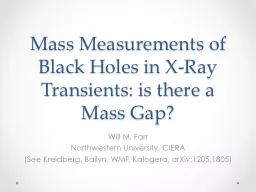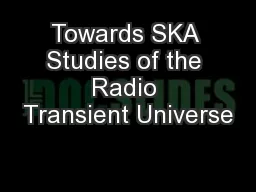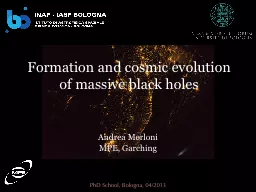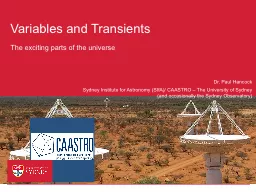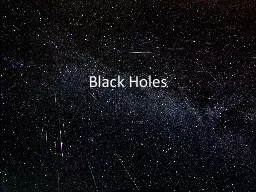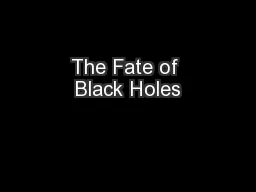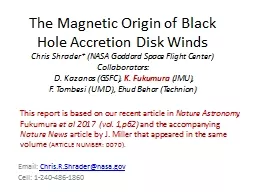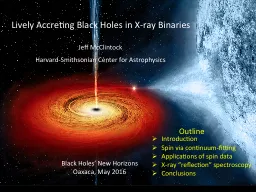PPT-Mass Measurements of Black Holes in X-Ray Transients: is th
Author : tatyana-admore | Published Date : 2015-10-17
Will M Farr Northwestern University CIERA See Kreidberg Bailyn WMF Kalogera arXiv12051805 The Mass Gap Strange because mainsequence mass distribution rising
Presentation Embed Code
Download Presentation
Download Presentation The PPT/PDF document "Mass Measurements of Black Holes in X-Ra..." is the property of its rightful owner. Permission is granted to download and print the materials on this website for personal, non-commercial use only, and to display it on your personal computer provided you do not modify the materials and that you retain all copyright notices contained in the materials. By downloading content from our website, you accept the terms of this agreement.
Mass Measurements of Black Holes in X-Ray Transients: is th: Transcript
Will M Farr Northwestern University CIERA See Kreidberg Bailyn WMF Kalogera arXiv12051805 The Mass Gap Strange because mainsequence mass distribution rising at low M . IU Astronomy. Mini-University 2014. Monster Black Holes. What . is a . black . h. ole. ,. anyway?. A black hole is….. …an object whose gravity is so intense that light cannot escape. How Big . Peter Hall, Tim Colegate, J-P Macquart, Nathan Clarke, Steven Tingay, Cathryn Trott and Randall Wayth. ICRAR / Curtin Institute of Radio Astronomy. Overview. Fast transients in radio astronomy. < 5 s duration for the purpose of this talk. Formation and cosmic evolution of massive black holes. Andrea Merloni. MPE, Garching. Syllabus. Monday:. Observational evidence of Supermassive Black Holes. AGN surveys. Tuesday: . The evolution of SMBH mass function and spin distributions. ELCT222- Lecture Notes. University of S. Carolina. Spring 2012. Outline. RC transients charging. RC transients discharge. RC transients . Thevenin. P-SPICE. RL transients charging. RL transients discharge. The exciting parts of the universe. Sydney Institute for Astronomy (. SIfA. )/ CAASTRO – The University of Sydney. Dr. Paul Hancock. (and occasionally the Sydney Observatory). Transients are Extreme. . Holes. Ginnie Baldwin. PHYSICS 1050: Astronomy. Fall 2011. BLACK HOLE. WHAT IS A BLACK HOLE?. A black hole is a concentration of matter so dense that not even light can escape its gravitational pull.. Escape Velocity. The minimum velocity needed to leave the vicinity of a body without ever being pulled back by the . body’. s . gravity is the . escape velocity. . . Escape Velocity. The escape velocity from a body depends on its . Implementation & Validation Phase. Isobel Hook. Jean-Philippe Beaulieu . 1. Euclid’s time-domain data. Euclid’s deep fields will be observed several times . Of order 40 . sq. . deg. , observed ~ 40 times. . The Obvious Question. Once matter enters a black hole, is it fated never to reappear? . The answer seemed obvious – a clear . “. yes. ”. . – until about . forty . years . ago.. Oops!. Apparently not! . blue hole. is a submarine cave or underwater sinkhole. They are also called vertical caves. There are many different blue holes located around the world, from Belize and the Bahamas to the Red Sea. Blue holes are roughly circular, steep-walled depressions, and so named for the dramatic contrast between the dark blue, deep waters of their depths and the lighter blue of the shallows around them.. The Magnetic Origin of Black Hole Accretion Disk Winds Chris Shrader* (NASA Goddard Space Flight Center ) Collaborators: D. Kazanas (GSFC), K. Fukumura (JMU), F. Tombesi (UMD), Ehud Behar ( Simeon Bird . (JHU). I. Cholis, J. Munoz, Y. Ali-Haimoud, M. Kamionkowski, E. Kovetz, A. Raccanelli, A. Riess. PRL 116 201301. arXiv: 1603.00464. LIGO detected Gravitational Waves. LIGO Detection. Two merging 30 solar mass BHs. Jeff McClintock. Harvard-Smithsonian Center for Astrophysics. Black Holes’ New Horizons. Oaxaca, May 2016 . Introduction. Spin via continuum-fitting. Applications of spin data. X-ray “reflection” spectroscopy. catalog. Eric Thrane (Monash University). October 24, 2019. The 2. nd. . Pietro. . Baracchi. Conference. Welcome to the era of routine detections!. Thirty-three . new events since the beginning of the third observing run on April 1..
Download Document
Here is the link to download the presentation.
"Mass Measurements of Black Holes in X-Ray Transients: is th"The content belongs to its owner. You may download and print it for personal use, without modification, and keep all copyright notices. By downloading, you agree to these terms.
Related Documents

